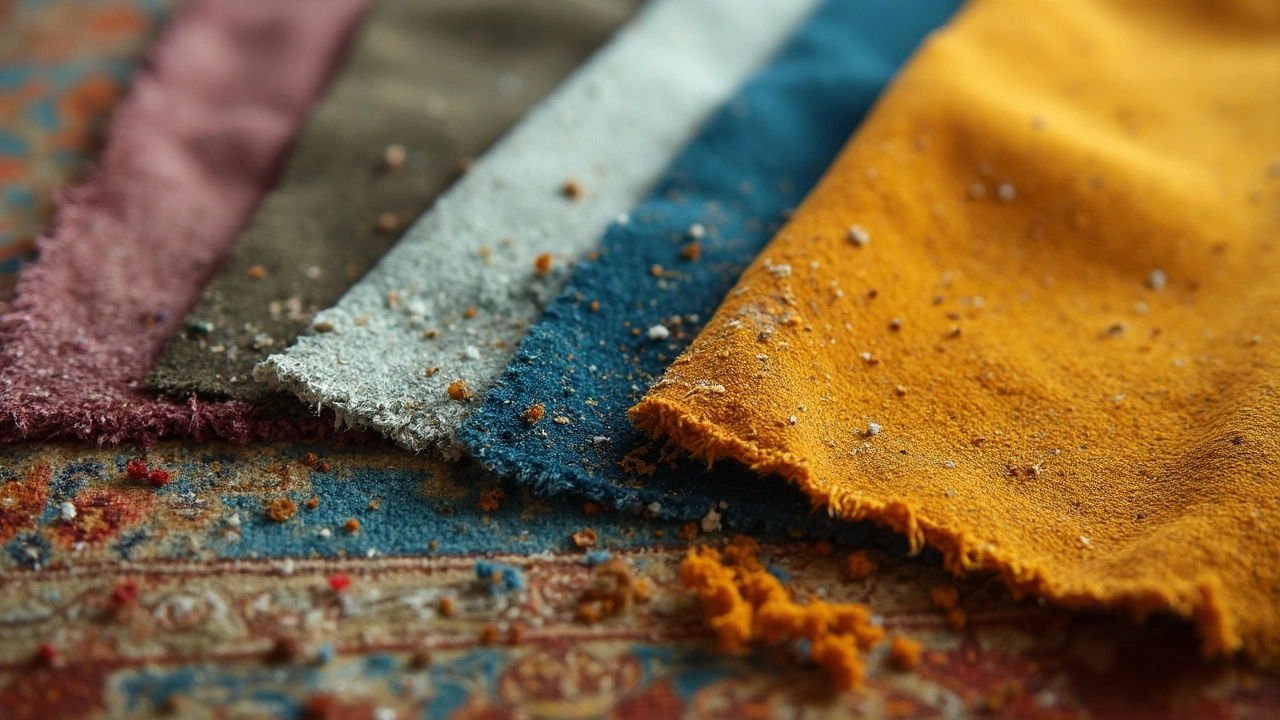Hardest Couch Material to Clean: What You Should Know Before You Buy

Ever tried to wipe up a spilled glass of red wine or greasy chip dip off your coach and only made things worse? You’re not alone. When it comes to cleaning couches, not all materials are created equal, and picking the wrong one can turn every snack night into a disaster scene.
Some fabrics practically laugh at your stain remover sprays. Others soak up smells like they’re hoarding them for winter. If you’re shopping for a new couch or battling one that already lives in your living room, knowing which materials put up the biggest fight during cleaning can save you a ton of stress down the road.
You don’t have to be an expert to understand the basics—a little know-how means fewer panicked moments (and maybe less anxiety when your friend shows up with a latte in hand). Let’s dig into why some fabrics are particularly difficult, and what really happens when accidents strike the most stubborn upholstery.
- Why Some Couch Fabrics Are Impossible to Clean
- The Material at the Top of the Tough List
- Real-Life Spills: How the Hardest Fabric Reacts
- Can You Save a Stained Couch? Honest Tips
- Smarter Alternatives (If You Like Easy Cleaning)
Why Some Couch Fabrics Are Impossible to Clean
Ever notice how some couches grab onto stains and smells and just won't let go? The secret is all in the fabric. Some sofa materials just don't play nice when messes happen, and it comes down to how they’re made.
Fabrics like silk, velvet, and certain kinds of cotton are pretty much sponges for spills. They’re woven with tiny threads and lots of nooks for dirt or liquid to crawl into. That means when you spill something like soda or tomato sauce, it doesn’t just sit on top — it dives right in and spreads fast. Even with serious scrubbing, you might only push the mess deeper.
On top of that, delicate fabrics often don’t get along with regular cleaning products. Spray the wrong cleaner on velvet or silk, and you’ll see weird marks or faded patches right where the stain used to be. Some of these materials actually change texture or lose color just from water — talk about adding insult to injury.
If you or your family have pets or eat in the living room, think twice before going for anything labeled “delicate.” Dry cleaning is the only safe way to clean many fancy couches, and that can get expensive fast. Here’s a breakdown of how different common couch materials handle cleaning:
| Sofa Material | Stain Resistance | Odor Resistance | Cleaning Method |
|---|---|---|---|
| Silk | Poor | Poor | Dry clean only |
| Velvet | Low | Moderate | Professional clean |
| Cotton (untreated) | Low | Low | Spot clean (risky) |
| Microfiber | High | High | Easy to clean |
So why does this matter? If you want a couch that looks good (and smells normal) year-round, picking the right couch cleaning strategy starts with knowing how that fabric fights against stains, dirt, and odors. It’s not just marketing — some textiles were never meant for grubby hands or pizza parties.
The Material at the Top of the Tough List
So what wins the title of toughest couch fabric to clean? Hands down, it’s microfiber when not treated—especially the darker “suede” style. At first glance, microfiber seems like a great pick. It’s soft, looks good, and feels comfy. But here’s the catch: regular, untreated microfiber grabs onto stains like a jealous ex. Spills sink in fast. Oils from pizza, lotion, or even your skin leave marks almost like ink on paper.
If you ask anyone who’s tried to get gum or ink out of microfiber, they’ll probably tell you it borders on impossible. Sure, there are special cleaners and DIY hacks, but they usually shift the mess around or leave a water ring behind. Microfiber’s tight weave traps tiny particles and hair so well, it laughs at standard vacuuming. Some pet owners say they spend longer cleaning the couch than the dog sheds in the first place.
Just to give you a quick idea of how cleaning compares:
| Couch Material | Stain Absorption (1=Low, 5=High) | Clean-Up Success (1=Difficult, 5=Easy) |
|---|---|---|
| Microfiber (Untreated) | 5 | 1 |
| Leather | 2 | 4 |
| Cotton | 3 | 3 |
The problem is, most people don’t realize how much of a pain microfiber can be until after a major spill. Even water can leave behind stubborn rings if you’re not super careful—and nobody wants a water stain as their new living room centerpiece. If you’ve got kids, pets, or a habit of eating on the couch, microfiber (unless it’s properly protected by a treatment) will test your patience more than most materials on the market.

Real-Life Spills: How the Hardest Fabric Reacts
If you’re wondering which couch fabric is the superstar pain in the neck, it’s suede—especially natural suede. When it comes to couch cleaning, suede acts like every stain is a permanent tattoo. The second you spill coffee, it seeps deep and spreads, making the mark look even bigger. Water alone can leave a stain that looks worse than the original mess.
Microfiber, often mistaken for suede, can be tough too, but nothing takes the cake like real suede. The problem comes from its open pores and nappy surface, which eagerly soak up liquids and oils. Let’s say someone drops a slice of pizza—within minutes, the grease works right into the fibers. Rubbing with a cloth usually just mushes things in deeper or leaves a mark where you tried to clean.
Check out some spill reactions you might face with these headache-prone materials:
- Red wine: Instantly turns into a giant purple blotch. Even specialty cleaners have a hard time pulling out all the color once it’s fully absorbed.
- Grease or oil: Almost always creates a dark, shiny spot that grows over time. Grease seems to stick around for good, no matter how fast you act.
- Water: Not as harmless as you’d hope—just a few drops can leave an ugly ring or texture change.
- Ink or marker: Nearly impossible to get out—any attempts can just smear it across a bigger area.
Here’s a quick look at how stains set on the most stubborn couch material after common spills:
| Spill Type | How Fast It Sets | Long-Term Effect |
|---|---|---|
| Red Wine | Immediate | Permanent hue, hard to mask |
| Oil/Grease | Minutes | Indelible dark spot, changes fabric texture |
| Water | Seconds | Water ring, stiffer area |
| Ink | Immediate | Very noticeable, rarely comes out |
If you’ve got pets or kids (or just clumsy friends), these fabrics are really unforgiving. Even if you’re on stain patrol, you’ll probably end up covering problem areas with a throw blanket more often than not. It’s no wonder a lot of folks with real suede sofas are always on edge during movie nights or parties.
Can You Save a Stained Couch? Honest Tips
If you've spilled something nasty on a couch made from a hard-to-clean material, you usually have a small window before that stain becomes a part of your furniture forever. Sadly, nothing makes sofa materials like suede, velvet, or certain types of microfibers magically reject stains. These materials hang onto spills, dirt, and even pet hair like their life depends on it.
But don’t panic just yet. There are a few things you can do to give your couch cleaning efforts a fighting chance.
- Act fast. The longer a stain sits, the harder it sets. Grab a clean, dry cloth and blot (don’t rub!) up as much of the mess as possible. Rubbing only spreads the stain.
- Check the tag. Most couches have a cleaning code—"W" for water-based cleaner, "S" for solvent-based, "WS" for either, and "X" means vacuum only. Ignoring this is an easy way to ruin sofa materials for good.
- Use the right cleaner. For tough fabrics like velvet, you might need a specialty foam or dry-cleaning solvent. Never dump water on velvet or genuine suede; that usually just leaves a big watermark behind.
- Gentle brushing helps. For velvet, gently brush the fabric to lift the nap after cleaning. This keeps it from looking matted.
- Try white vinegar for odors. Dilute with water and lightly blot—never soak. Let it air out fully.
Cleaning professionals say most stains left for over 24 hours on suede or velvet are pretty much permanent. According to a 2023 upholstery care survey, 61% of folks with these materials have paid for at least one pro cleaning per year—way higher than average. Here’s a look at how hard it actually is to save seats, based on material:
| Material | Easy to Save? | Pro Cleaning Needed? |
|---|---|---|
| Velvet | Rarely | Often |
| Suede | Very tough | Usually |
| Microfiber | Sometimes | Occasionally |
| Cotton Blend | Moderate | Not always |
Honestly, if your stain won’t budge or if you’re worried about making it worse, sometimes the smartest move is to call a pro. Just don’t expect miracles—there are limits, even with the best cleaning tricks.

Smarter Alternatives (If You Like Easy Cleaning)
If you’re tired of wrestling with stains and scrubbing until your arms ache, you’re going to want a couch cleaning upgrade. Luckily, there are several couch materials made for people who actually want to relax on their furniture—without panic every time someone brings over takeout.
First up is microfiber. This fabric is the MVP for families, pet owners, or really anyone who eats on the couch (so, almost everyone). Microfiber has tightly woven fibers that make it hard for spills and dirt to sink in. Often, a quick wipe with a little soap and water is enough to tackle messes.
Next, leather. While it looks fancy, leather is basically the easy-cleaning king. You can just wipe up most spills with a damp cloth. Leather doesn’t grab onto odors or crumbs like fabric options do. It can scratch, yes, but you usually don’t have to worry about major stains unless you let a spill sit for days.
If you want something even more bulletproof, check out sofas labeled as “performance fabric” or “stain-resistant fabric.” Brands treat these materials with a special finish so liquids bead up and crumbs can be vacuumed off in seconds. According to a 2023 report from the American Upholstery Association, stains on performance fabrics are about 70% less likely to set compared to untreated cotton or linen couches.
Here’s a quick side-by-side on cleaning some easy-upkeep couch types:
| Material | Stain Resistance | Cleaning Method | Smell Absorption |
|---|---|---|---|
| Microfiber | High | Soap + water, vacuum | Low |
| Leather | Moderate to High | Wipe with damp cloth | Low |
| Performance Fabric | Very High | Spot clean, vacuum | Very Low |
If you’re allergic to chores, stick with any of these. Avoid light-colored cotton, velvet, or untreated linen if you can’t stand scrubbing. Remember, any sofa material can be easier if you get covers that are machine washable. Don’t forget—no matter what you pick, always check those cleaning tags and test new cleaners on a hidden spot first to avoid big regrets.